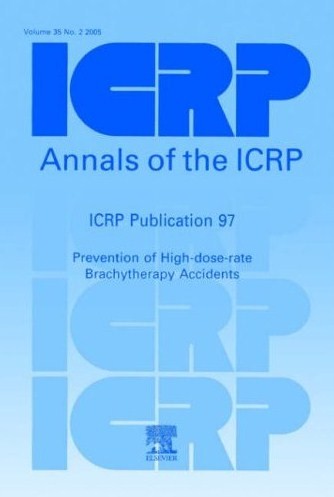ICRP Publication 97
Prevention of High-dose-rate Brachytherapy Accidents
Recommended citation
ICRP, 2005. Prevention of High-dose-rate Brachytherapy Accidents. ICRP Publication 97. Ann. ICRP 35 (2).
Abstract - High-dose-rate (HDR) brachytherapy is a rapidly growing technique that has been replacing low-dose-rate (LDR) procedures over the last few years in both industrialised and developing countries. It is estimated that about 500,000 procedures (administrations of treatment) are performed by HDR units annually. LDR equipment has been discontinued by many manufacturers over the last few years, leaving HDR brachytherapy as the major alternative.
HDR brachytherapy techniques deliver a very high dose, of the order of 1.6–5.0 Gy/min, so mistakes can lead to under- or over dosage with the potential for clinical adverse effects. More than 500 HDR accidents (including one death) have been reported along the entire chain of procedures from source packing to delivery of dose. Human error has been the prime cause of radiation events. In the present report, the International Commission on Radiological
Protection concludes that many accidents could have been prevented if staff had had functional monitoring equipment and paid attention to the results.
Since iridium has a relatively short half-life, the HDR sources need to be replaced approximately every 4 months. Over 10,000 HDR sources are transported annually, with the resultant potential for accidents; therefore, appropriate procedures and regulations must be observed.
A number of specific recommendations on procedures and equipment are given in this report. The need for an emergency plan and for practising emergency procedures is stressed. The possibility of loss or theft of sources must be kept in mind.
A collaborating team of specifically trained personnel following quality assurance (QA) procedures is necessary to prevent accidents. Maintenance is an indispensable component of QA; external audits of procedures reinforce good and safe practice, and identify potential causes of accidents. QA should include peer review of cases. Accidents and incidents should be reported and the lessons learned should be shared with other users to prevent similar mistakes.
ICRP, 2005. Prevention of High-dose-rate Brachytherapy Accidents. ICRP Publication 97. Ann. ICRP 35 (2).
Abstract - High-dose-rate (HDR) brachytherapy is a rapidly growing technique that has been replacing low-dose-rate (LDR) procedures over the last few years in both industrialised and developing countries. It is estimated that about 500,000 procedures (administrations of treatment) are performed by HDR units annually. LDR equipment has been discontinued by many manufacturers over the last few years, leaving HDR brachytherapy as the major alternative.
HDR brachytherapy techniques deliver a very high dose, of the order of 1.6–5.0 Gy/min, so mistakes can lead to under- or over dosage with the potential for clinical adverse effects. More than 500 HDR accidents (including one death) have been reported along the entire chain of procedures from source packing to delivery of dose. Human error has been the prime cause of radiation events. In the present report, the International Commission on Radiological
Protection concludes that many accidents could have been prevented if staff had had functional monitoring equipment and paid attention to the results.
Since iridium has a relatively short half-life, the HDR sources need to be replaced approximately every 4 months. Over 10,000 HDR sources are transported annually, with the resultant potential for accidents; therefore, appropriate procedures and regulations must be observed.
A number of specific recommendations on procedures and equipment are given in this report. The need for an emergency plan and for practising emergency procedures is stressed. The possibility of loss or theft of sources must be kept in mind.
A collaborating team of specifically trained personnel following quality assurance (QA) procedures is necessary to prevent accidents. Maintenance is an indispensable component of QA; external audits of procedures reinforce good and safe practice, and identify potential causes of accidents. QA should include peer review of cases. Accidents and incidents should be reported and the lessons learned should be shared with other users to prevent similar mistakes.
